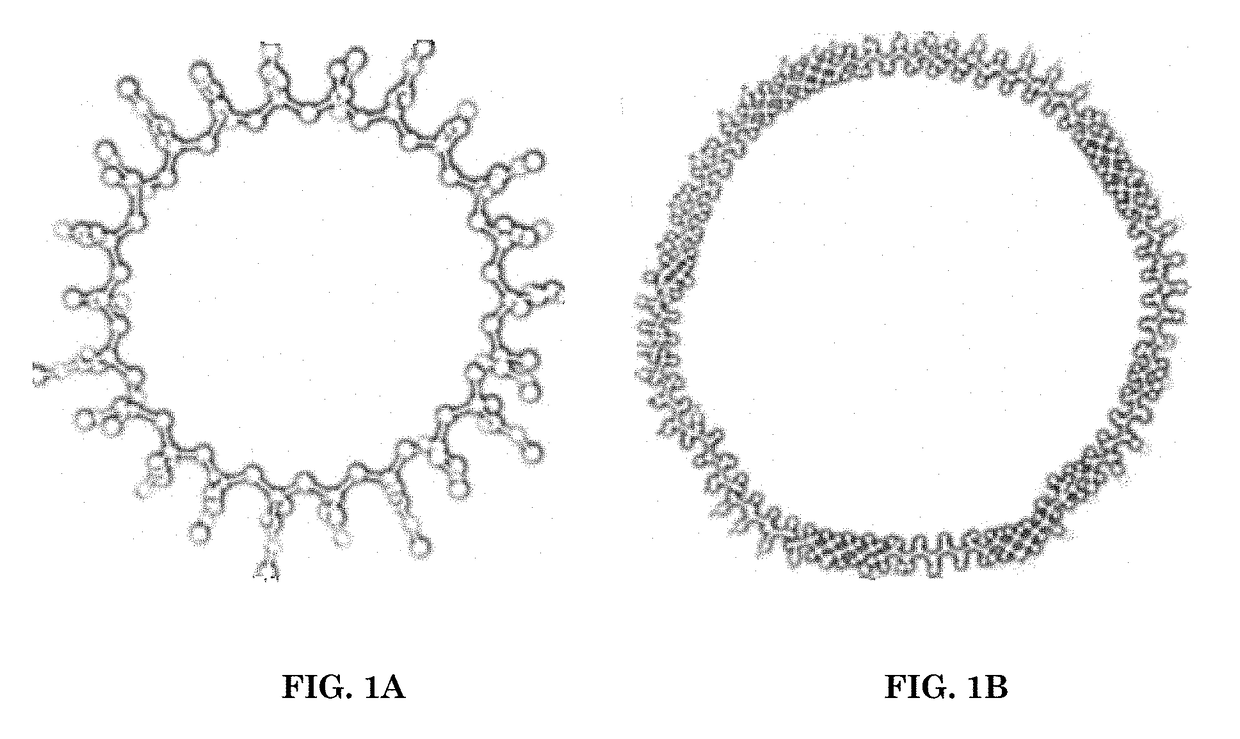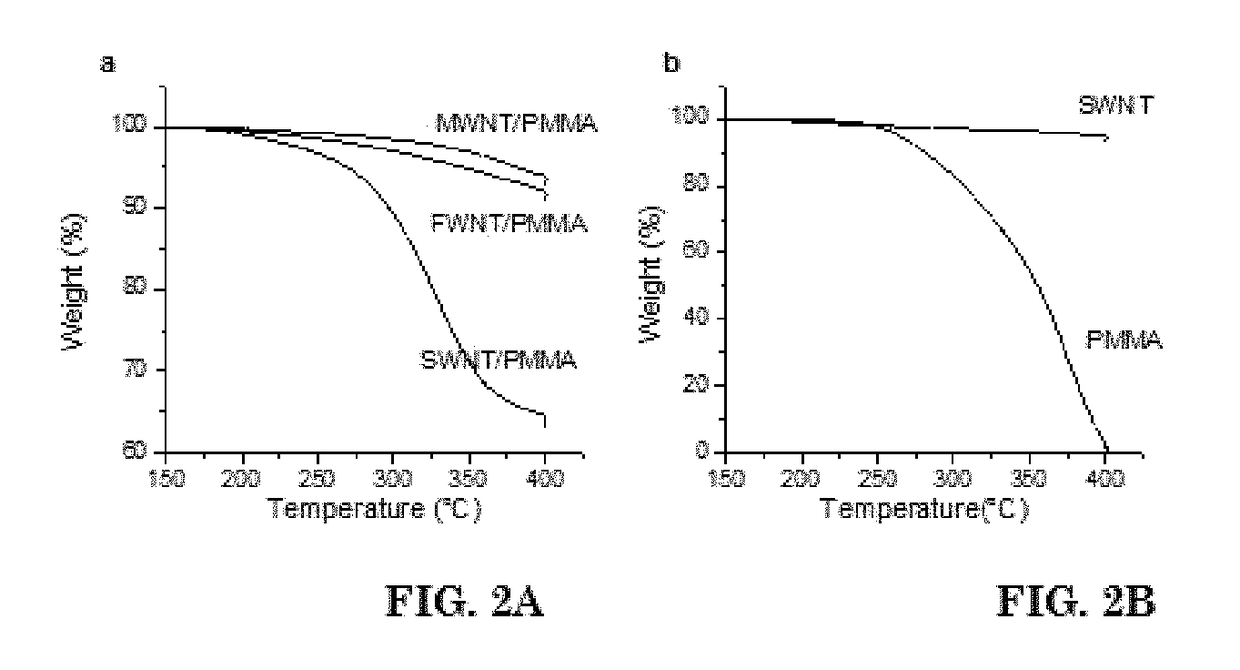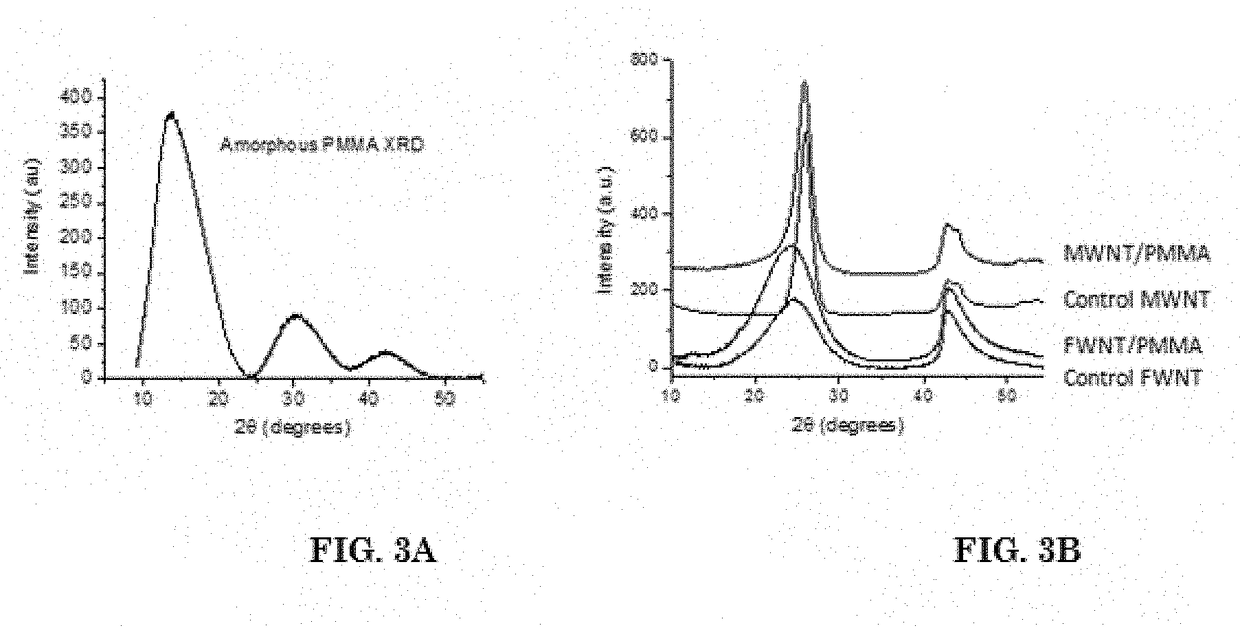Ordered Wrapping of Poly(Methyl Methacrylate) on Single Wall Carbon Nanotubes
a carbon nanotube and polymer technology, applied in single-walled nanotubes, chemistry apparatuses and processes, textiles and paper, etc., can solve the problems of limiting the applicability of carbon nanotubes as functional fillers in other materials or as free-standing cnt films, affecting the intended functional properties, and other problems, such as toluene and methyl ethyl ketone, are not as good
- Summary
- Abstract
- Description
- Claims
- Application Information
AI Technical Summary
Benefits of technology
Problems solved by technology
Method used
Image
Examples
example 1
CNT Suspension Quality and its Influence on Buckypaper and Film Quality
[0096]The suspendability of CNTs are generally low, even in good solvents. In order to get a good SWNT suspension during sonication, a concentration of at most about 14 mg / L is required. If the concentration of the SWNTs is too high, the nanotubes will not disperse regardless of the sonication time.
[0097]FIGS. 10A-B show that as sonicated SWNT / DMF and SWNT / PMMA / DMF suspensions had similar appearance initially. However, FIGS. 10C-D show that the SWNT / DMF suspension precipitated within 2 hours of centrifugation at 2,000 g while the SWNT / PMMA / DMF dispersion was quite stable and exhibited very little sedimentation under comparable centrifugation conditions. This SWNT / PMMA / DMF suspension exhibited no further change even after prolonged centrifugation time of 72 hours, and it remained stable indefinitely (observed for 3 months).
[0098]The dispersion quality will have an influence on the preparation of films, fibers buck...
example 2
UV-Vis Spectroscopy of Suspension
[0101]UV-vis spectroscopy was used to show absorption spectra of the SWNT / DMF and SWNT / PMMA / DMF suspensions before and after centrifugation. The suspensions were centrifuged for 2 hours at 10,000 RPM and the supernatants were collected for UV-vis. The SWNT / DMF suspension shows much lower absorbance after centrifugation, likely due to higher re-aggregation and sedimentation of the nanotubes, resulting in lower SWNT concentration in the supernatant. The van Hove transitions in SWNT / PMMA / DMF were blue shifted 12-24 meV as compared to SWNT / DMF both before and after centrifugation. The van Hove transition energy of nanotubes redshift upon bundling. O'Connell, M. J., S. Sivaram, and S. K. Doorn, Near-infrared resonance Raman excitation profile studies of single-walled carbon nanotube intertube interactions: A direct comparison of bundled and individually dispersed. Physical Review B, 2004. 69(23): p. 235415. This indicates that the SWNT reaggregation start...
example 3
[0102]Monitoring Aggregation Using Raman Spectroscopy
[0103]In FIG. 11A the Raman spectra, using a 785 nm laser, shows higher intensity for (12,1), (10,5) and (9,7) and lower intensity for (10,2), (9,4) and (13,3) nanotubes for SWNT / PMMA compared to SWNT samples; at that laser energy the former three nanotubes are in resonance when individualized while the latter three are in resonance while bundled (O'Connell, M. J., S. Sivaram, and S. K. Doorn, Near-infrared resonance Raman excitation profile studies of single-walled carbon nanotube intertube interactions: A direct comparison of bundled and individually dispersed. Physical Review B, 2004. 69(23): p. 235415), showing the influence of polymer wrapping on individualizing the nanotubes. The Raman profile of the SWNT / PMMA sample is similar to that of SDS / SWNT, where the SDS surfactant is intended to exfoliate the bundled nanotubes. Mayo, M. L., D. Hogle, B. Yilmaz, M. E. Kose, and S. Kilina, Morphology and dispersion of polycarbazole wr...
PUM
| Property | Measurement | Unit |
|---|---|---|
| Specific surface area | aaaaa | aaaaa |
| Specific surface area | aaaaa | aaaaa |
| Volume | aaaaa | aaaaa |
Abstract
Description
Claims
Application Information
 Login to View More
Login to View More - R&D
- Intellectual Property
- Life Sciences
- Materials
- Tech Scout
- Unparalleled Data Quality
- Higher Quality Content
- 60% Fewer Hallucinations
Browse by: Latest US Patents, China's latest patents, Technical Efficacy Thesaurus, Application Domain, Technology Topic, Popular Technical Reports.
© 2025 PatSnap. All rights reserved.Legal|Privacy policy|Modern Slavery Act Transparency Statement|Sitemap|About US| Contact US: help@patsnap.com



